Physiological Characteristics, Crop Growth and Grain Yield of Twelve Wheat Varieties Cultivated in the North China Plain
Abstract
:1. Introduction
2. Materials and Methods
2.1. Experimental Site
2.2. Experimental Design
2.3. Data Collection and Preprocessing
2.3.1. Climate Data
2.3.2. Soil Water Data
2.3.3. Crop Growth Data
2.3.4. Crop Physiological Data
2.4. Calculation of Indicators
2.5. Statistical Analysis
3. Results
3.1. Meteorological Conditions and Soil Water Content
3.2. Crop Growth Characteristics
3.3. Crop Physiological Characteristics
3.4. Wheat Grain Yield and Water Productivity
3.5. Relationships between Wheat Yield and Growth and Physiological Indicators
4. Discussion
4.1. Relationship between Physiological Indicators and Soil Water Content
4.2. Relationship between Yield Factors and Physiological and Ecological Indicators
4.3. Selecting High-Yield and Drought-Resistant Wheat Varieties
5. Conclusions
- (1)
- In the natural meteorological environments and under deficit irrigation, the PHm of each wheat variety was relatively stable over time, but there were obvious changes in PDm, LAIm, and DMm.
- (2)
- The gas exchange parameters and fluorescence parameters in wheat flag leaves were closely related to soil water content. Generally, Pn, Tr, Gs, ΦPSII, and SWC showed a clear change pattern with growth as follows (from high to low): heading stage > middle grain-filling stage > late grain-filling stage in the dry season, and middle grain-filling stage > heading stage > late grain-filling stage in the normal precipitation/climatic season.
- (3)
- Compared with the normal precipitation/climatic wheat season (2019–2020 season), the changes in yield, ETa, and WP of the 12 varieties were −25%, −7%, and −19% in the 2018–2019 season and −1%, −3%, and 2% in the 2020–2021 season, respectively. The much lower yield in the 2018–2019 season was due to the lower spike number, grain number per spike, and 1000-grain weight. The lower yield in the 2020–2021 season was due to the low spike number.
- (4)
- Wheat yield showed a positive correlation with PDm, LAIm, DMm, ETa, HI, and WP at a significance level of 0.01. High-yield wheat varieties had stronger photosynthetic rates in the middle and late grain-filling stages. These growth and physiological parameters can be used to address climate change in wheat production in the NCP as well as other regions in the world.
- (5)
- Based on yield and WP, the varieties Yingbo700, Lunxuan103, Shimai26, Shinong086, Han6172, and Hanong1412 are recommended for cultivation, as they possess high yield potential and drought resistance capacity in the North China Plain.
Author Contributions
Funding
Data Availability Statement
Acknowledgments
Conflicts of Interest
References
- Kumari, A.; Lakshmi, G.A.; Krishna, G.K.; Patni, B.; Prakash, S.; Bhattacharyya, M.; Singh, S.K.; Verma, K.K. Climate change and its impact on crops: A comprehensive investigation for sustainable agriculture. Agronomy 2022, 12, 3008. [Google Scholar] [CrossRef]
- Zhao, C.; Liu, B.; Piao, S.; Wang, X.; Lobell, D.B.; Huang, Y.; Huang, M.; Yao, Y.; Bassu, S.; Ciais, P.; et al. Temperature increase reduces global yields of major crops in four independent estimates. Proc. Natl. Acad. Sci. USA 2017, 114, 9326. [Google Scholar] [CrossRef] [PubMed]
- Lesk, C.; Rowhani, P.; Ramankutty, N. Influence of extreme weather disasters on global crop production. Nature 2016, 529, 84–87. [Google Scholar] [CrossRef] [PubMed]
- Islam, A.F.M.T.; Islam, A.K.M.S.; Islam, G.M.T.; Bala, S.K.; Salehin, M.; Choudhury, A.K.; Dey, N.C.; Hossain, A. Adaptation strategies to increase water productivity of wheat under changing climate. Agric. Water Manag. 2022, 264, 107499. [Google Scholar] [CrossRef]
- Wang, X.; Li, L.; Ding, Y.; Xu, J.; Wang, Y.; Zhu, Y.; Wang, X.; Cai, H. Adaptation of winter wheat varieties and irrigation patterns under future climate change conditions in Northern China. Agric. Water Manag. 2021, 243, 106409. [Google Scholar] [CrossRef]
- Rogger, J.; Hund, A.; Fossati, D.; Holzkämper, A. Can Swiss wheat varieties escape future heat stress? Eur. J. Agron. 2021, 131, 126394. [Google Scholar] [CrossRef]
- Yuan, Y.; Liu, L.; Gao, Y.; Yang, Q.; Dong, K.; Liu, T.; Feng, B. Comparative analysis of drought-responsive physiological and transcriptome in broomcorn millet (Panicum miliaceum L.) genotypes with contrasting drought tolerance. Ind. Crop. Prod. 2022, 177, 114498. [Google Scholar] [CrossRef]
- Urban, O.; Hlaváová, M.; Klem, K.; Novotná, K.; Rapantová, B.; Smutná, P.; Horáková, V.; Hlavinka, P.; Karpa, P.; Trnka, M. Combined effects of drought and high temperature on photosynthetic characteristics in four winter wheat genotypes. Field Crops Res. 2018, 223, 137–149. [Google Scholar] [CrossRef]
- Liu, E.K.; Mei, X.R.; Yan, C.R.; Gong, D.Z.; Zhang, Y.Q. Effects of water stress on photosynthetic characteristics, dry matter translocation and WUE in two winter wheat genotypes. Agric. Water Manag. 2016, 167, 75–85. [Google Scholar] [CrossRef]
- Bergkamp, B.; Impa, S.M.; Asebedo, A.R.; Fritz, A.K.; Jagadish, S.V.K. Prominent winter wheat varieties response to post-flowering heat stress under controlled chambers and field based heat tents. Field Crops Res. 2018, 222, 143–152. [Google Scholar] [CrossRef]
- Tesfaye, K.; Kruseman, G.; Cairns, J.E.; Zaman-Allah, M.; Wegary, D.; Zaidi, P.H.; Boote, K.J.; Rahut, D.; Erenstein, O. Potential benefits of drought and heat tolerance for adapting maize to climate change in tropical environments. Clim. Risk Manag. 2018, 19, 106–119. [Google Scholar] [CrossRef]
- Liu, L.; Xia, Y.; Liu, B.; Chang, C.; Xiao, L.; Shen, J.; Tang, L.; Cao, W.; Zhu, Y. Individual and combined effects of jointing and booting low-temperature stress on wheat yield. Eur. J. Agron. 2020, 113, 125989. [Google Scholar] [CrossRef]
- National Bureau of Statistics of the People’s Republic of China. China Statistical Yearbook; China Statistics Press: Beijing, China, 2022.
- Sun, H.; Zhang, X.; Liu, X.; Liu, X.; Shao, L.; Chen, S.; Wang, J.; Dong, X. Impact of different cropping systems and irrigation schedules on evapotranspiration, grain yield and groundwater level in the North China Plain. Agric. Water Manag. 2019, 211, 202–209. [Google Scholar] [CrossRef]
- Ti, J.; Yang, Y.; Yin, X.; Liang, J.; Pu, L.; Jiang, Y.; Wen, X. Spatio-temporal analysis of meteorological elements in the North China District of China during 1960–2015. Water 2018, 10, 789. [Google Scholar] [CrossRef]
- Li, X.; Cai, J.; Liu, F.; Zhou, Q.; Dai, T.; Cao, W.; Jiang, D. Wheat plants exposed to winter warming are more susceptible to low temperature stress in the spring. Plant Growth Regul. 2015, 77, 11–19. [Google Scholar] [CrossRef]
- Xiao, L.; Liu, L.; Asseng, S.; Xia, Y.; Tang, L.; Liu, B.; Cao, W.; Zhu, Y. Estimating spring frost and its impact on yield across winter wheat in China. Agric. For. Meteorol. 2018, 260–261, 154–164. [Google Scholar] [CrossRef]
- Wang, S.; Chen, J.; Rao, Y.; Liu, L.; Wang, W.; Dong, Q. Response of winter wheat to spring frost from a remote sensing perspective: Damage estimation and influential factors. ISPRS J. Photogramm. 2020, 168, 221–235. [Google Scholar] [CrossRef]
- Li, S.; Zhang, L.; Huang, B.; He, L.; Zhao, J.; Guo, A. A comprehensive index for assessing regional dry-hot wind events in Huang-Huai-Hai Region, China. Phys. Chem. Earth, Parts A/B/C 2020, 116, 102860. [Google Scholar] [CrossRef]
- Zhang, L.; Chu, Q.-Q.; Jiang, Y.-L.; Chen, F.; Lei, Y.-D. Impacts of climate change on drought risk of winter wheat in the North China Plain. J. Integr. Agric. 2021, 20, 2601–2612. [Google Scholar] [CrossRef]
- Chen, Y.; Zhang, Z.; Tao, F.; Palosuo, T.; Rötter, R.P. Impacts of heat stress on leaf area index and growth duration of winter wheat in the North China Plain. Field Crops Res. 2018, 222, 230–237. [Google Scholar] [CrossRef]
- Sun, H.; Shen, Y.; Yu, Q.; Flerchinger, G.N.; Zhang, Y.; Liu, C.; Zhang, X. Effect of precipitation change on water balance and WUE of the winter wheat–summer maize rotation in the North China Plain. Agric. Water Manag. 2010, 97, 1139–1145. [Google Scholar] [CrossRef]
- Tang, X.; Liu, H.; Yang, L.; Li, L.; Chang, J. Energy balance, microclimate, and crop evapotranspiration of winter wheat (Triticum aestivum L.) under sprinkler irrigation. Agriculture 2022, 12, 953. [Google Scholar] [CrossRef]
- Zhao, J.; Han, T.; Wang, C.; Jia, H.; Worqlul, A.W.; Norelli, N.; Zeng, Z.; Chu, Q. Optimizing irrigation strategies to synchronously improve the yield and water productivity of winter wheat under interannual precipitation variability in the North China Plain. Agric. Water Manag. 2020, 240, 106298. [Google Scholar] [CrossRef]
- Feng, W.; Shum, C.K.; Zhong, M.; Pan, Y. Groundwater storage changes in China from satellite gravity: An overview. Remote Sens. 2018, 10, 674. [Google Scholar] [CrossRef]
- Umair, M.; Hussain, T.; Jiang, H.; Ahmad, A.; Shen, Y. Water-saving potential of subsurface drip irrigation for winter wheat. Sustainability 2019, 11, 2978. [Google Scholar] [CrossRef]
- Tang, X.; Liu, H.; Feng, D.; Zhang, W.; Chang, J.; Li, L.; Yang, L. Prediction of field winter wheat yield using fewer parameters at middle growth stage by linear regression and the BP neural network method. Eur. J. Agron. 2022, 141, 126621. [Google Scholar] [CrossRef]
- Liu, X.; Pan, Y.; Zhu, X.; Yang, T.; Bai, J.; Sun, Z. Drought evolution and its impact on the crop yield in the North China Plain. J. Hydrol. 2018, 564, 984–996. [Google Scholar] [CrossRef]
- Feng, B.; Li, S.; Li, H.; Wang, Z.; Zhang, B.; Wang, F.; Kong, L. Effect of high temperature stress at early grain-filling stage on plant morphology and grain yield of different heat-resistant varieties of wheat. Chin. J. Eco-Agric. 2019, 27, 451–461. [Google Scholar]
- DB 37/T 4366; The Classification Standard of Winter Wheat Seedling Condition in Shandong Province. Shandong Provincial Department of Agriculture: Jinan, China, 2021.
- Guan, X.K.; Song, L.; Wang, T.C.; Turner, N.C.; Li, F.M. Effect of drought on the gas exchange, chlorophyll fluorescence and yield of six different-era spring wheat cultivars. J. Agron. Crop Sci. 2015, 201, 253–266. [Google Scholar] [CrossRef]
- Liu, H.; Yu, L.; Luo, Y.; Wang, X.; Huang, G. Responses of winter wheat (Triticum aestivum L.) evapotranspiration and yield to sprinkler irrigation regimes. Agric. Water Manag. 2011, 98, 483–492. [Google Scholar] [CrossRef]
- Feng, X.; Liu, H.; Feng, D.; Tang, X.; Li, L.; Chang, J.; Tanny, J.; Liu, R. Quantifying winter wheat evapotranspiration and crop coefficients under sprinkler irrigation using eddy covariance technology in the North China Plain. Agric. Water Manag. 2023, 277, 108131. [Google Scholar] [CrossRef]
- Liu, H.; Chang, J.; Tang, X.; Zhang, J. In Situ Measurement of Stemflow, Throughfall and Canopy Interception of Sprinkler Irrigation Water in a Wheat Field. Agriculture 2022, 12, 1265. [Google Scholar] [CrossRef]
- Liu, H.; Kang, Y.; Yao, S.M.; Sun, Z.Q.; Liu, S.P.; Wang, Q.G. Field evaluation on water productivity of winter wheat under sprinkler or surface irrigation in the north China plain. Irrig. Drain. 2013, 62, 37–49. [Google Scholar] [CrossRef]
- Li, L.; Zhao, J.; Wang, C.; Yan, C. Comprehensive evaluation of robotic global performance based on modified principal component analysis. Int. J. Adv. Robot. Syst. 2020, 17, 1729881419896881. [Google Scholar] [CrossRef]
- Jafarzadegan, M.; Safi-Esfahani, F.; Beheshti, Z. Combining hierarchical clustering approaches using the PCA method. Expert Syst. Appl. 2019, 137, 1–10. [Google Scholar] [CrossRef]
- Pinheiro, C.; Chaves, M.M. Photosynthesis and drought: Can we make metabolic connections from available data? J. Exp. Bot. 2011, 62, 869–882. [Google Scholar] [CrossRef] [PubMed]
- Tankari, M.; Wang, C.; Ma, H.; Li, X.; Li, L.; Soothar, R.K.; Cui, N.; Zaman-Allah, M.; Hao, W.; Liu, F.; et al. Drought priming improved water status, photosynthesis and water productivity of cowpea during post-anthesis drought stress. Agric. Water Manag. 2021, 245, 106565. [Google Scholar] [CrossRef]
- Farooq, M.; Wahid, A.; Kobayashi, N.; Fujita, D.; Basra, S.M.A. Plant drought stress: Effects, mechanisms and management. Agron. Sustain. Dev. 2009, 29, 185–212. [Google Scholar] [CrossRef]
- Zhao, W.; Liu, L.; Shen, Q.; Yang, J.; Han, X.; Tian, F.; Wu, J. Effects of water stress on photosynthesis, yield, and water use efficiency in winter wheat. Water 2020, 12, 2127. [Google Scholar] [CrossRef]
- Sharma, K.D.; Kumar, A. Identification of physiological and yield related traits of wheat (Triticum aestivum L.) under varying soil moisture stress. J. Agrometeorol. 2014, 16, 78–84. [Google Scholar] [CrossRef]
- Hlaváčová, M.; Klem, K.; Rapantová, B.; Novotná, K.; Urban, O.; Hlavinka, P.; Smutná, P.; Horáková, V.; Škarpa, P.; Pohanková, E.; et al. Interactive effects of high temperature and drought stress during stem elongation, anthesis and early grain filling on the yield formation and photosynthesis of winter wheat. Field Crops Res. 2018, 221, 182–195. [Google Scholar] [CrossRef]
- Meena, R.P.; Karnam, V.; Sendhil, R.; Sharma, R.K.; Tripathi, S.C.; Singh, G.P. Identification of water use efficient wheat genotypes with high yield for regions of depleting water resources in India. Agric. Water Manag. 2019, 223, 105709. [Google Scholar] [CrossRef]
- Lu, Y.; Yan, Z.; Li, L.; Gao, C.; Shao, L. Selecting traits to improve the yield and water use efficiency of winter wheat under limited water supply. Agric. Water Manag. 2020, 242, 106410. [Google Scholar] [CrossRef]
- Beche, E.; Benin, G.; da Silva, C.L.; Munaro, L.B.; Marchese, J.A. Genetic gain in yield and changes associated with physiological traits in Brazilian wheat during the 20th century. Eur. J. Agron. 2014, 61, 49–59. [Google Scholar] [CrossRef]
- Liu, K.; Shi, Y.; Yu, Z.; Zhang, Z.; Zhang, Y. Improving photosynthesis and grain yield in wheat through ridge-furrow ratio optimization. Agronomy 2023, 13, 2413. [Google Scholar] [CrossRef]
- Noor, H.; Yan, Z.; Sun, P.; Zhang, L.; Ding, P.; Li, L.; Ren, A.; Sun, M.; Gao, Z. Effects of nitrogen on photosynthetic productivity and yield quality of wheat (Triticum aestivum L.). Agronomy 2023, 13, 1448. [Google Scholar] [CrossRef]
- Chang, S.; Chang, T.; Song, Q.; Zhu, X.-G.; Deng, Q. Photosynthetic and agronomic traits of an elite hybrid rice Y-Liang-You 900 with a record-high yield. Field Crops Res. 2016, 187, 49–57. [Google Scholar] [CrossRef]
- Hebei Provincial Department of Agriculture. Recommended Water-Saving Wheat Varieties and Related Supporting Technology; Hebei Provincial Department of Agriculture: Shijiazhuang, China, 2020. [Google Scholar]
- Fan, L.; Lu, C.; Yang, B.; Chen, Z. Long-term trends of precipitation in the North China Plain. J. Geogr. Sci. 2012, 22, 989–1001. [Google Scholar] [CrossRef]
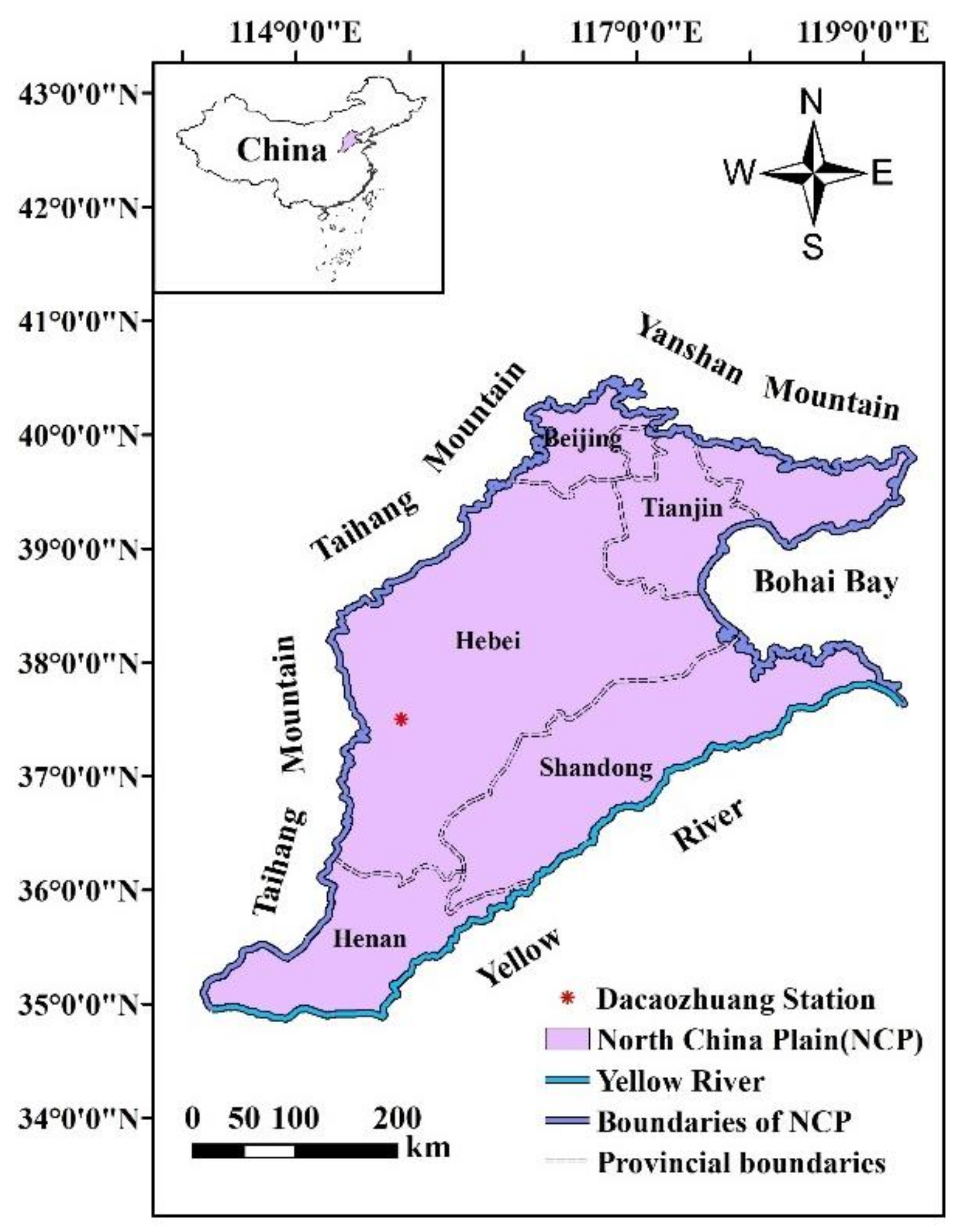
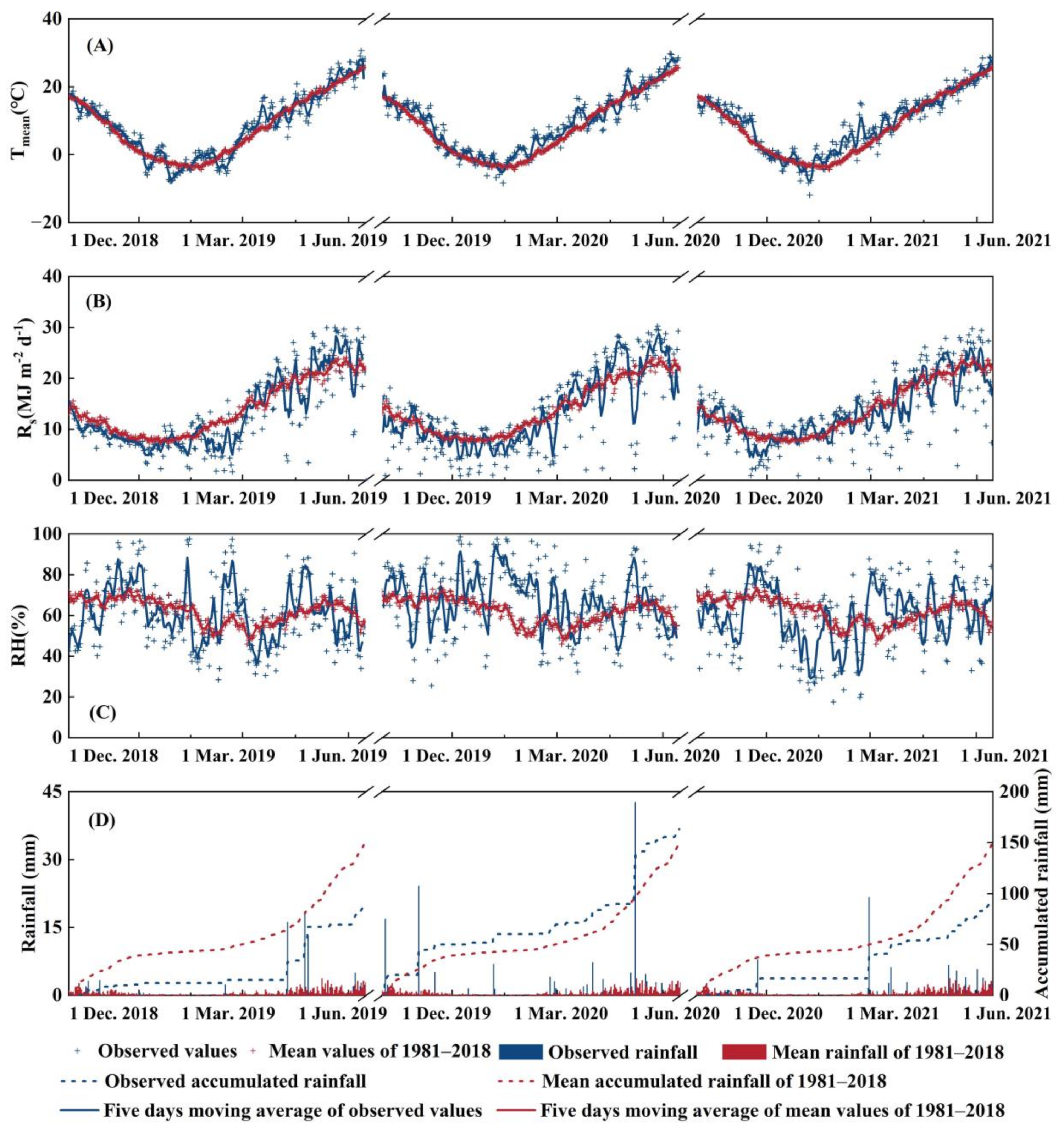
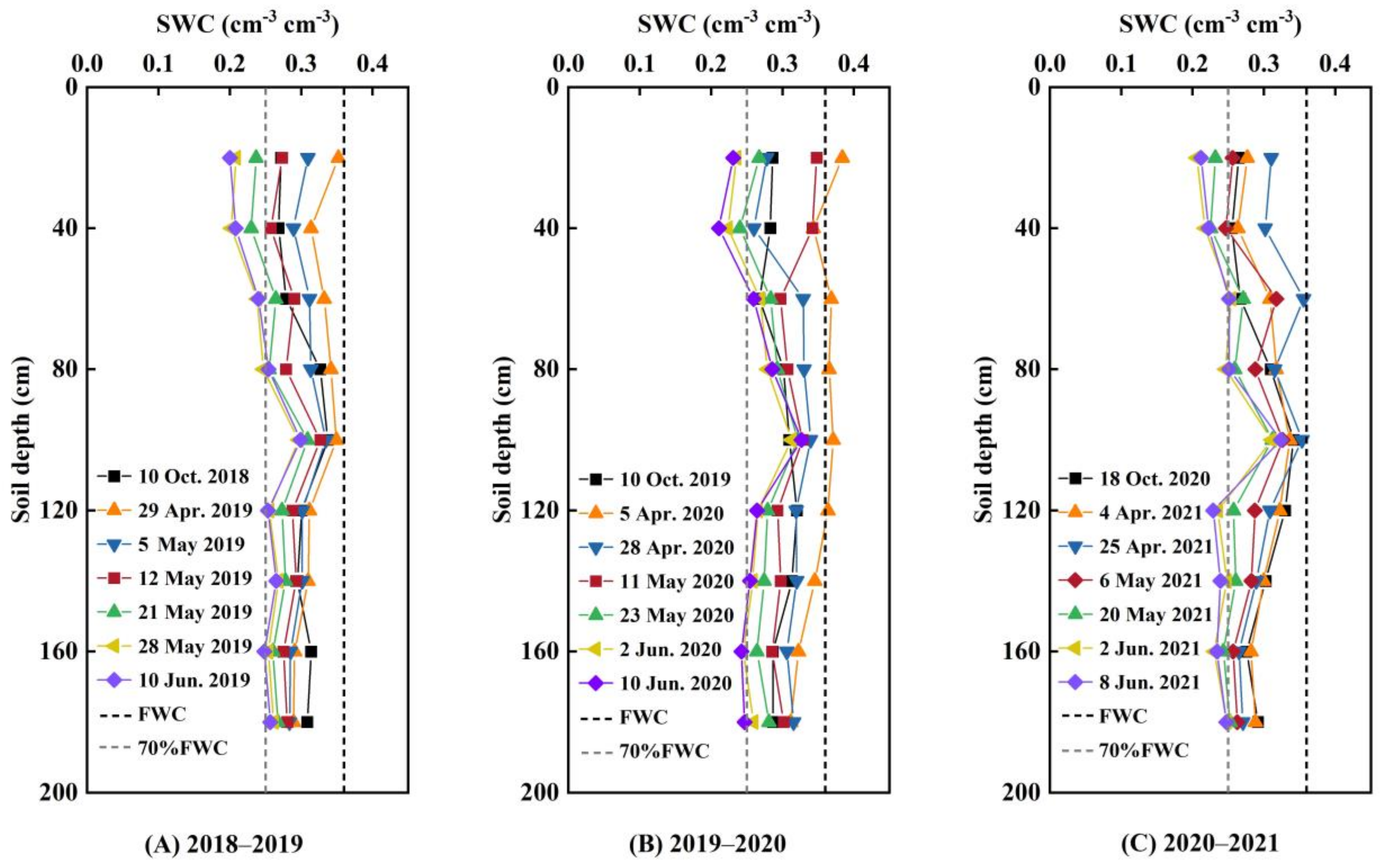
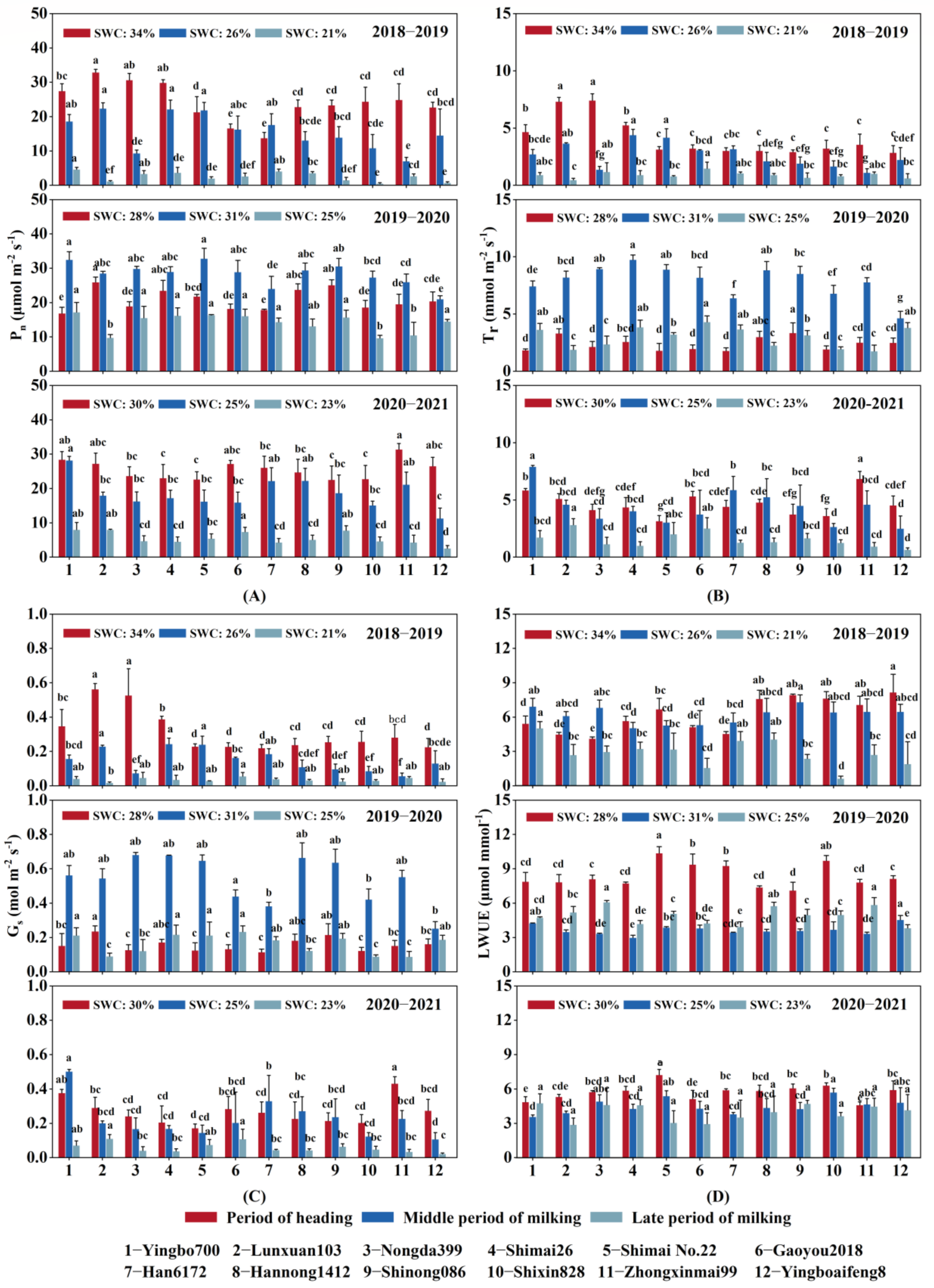
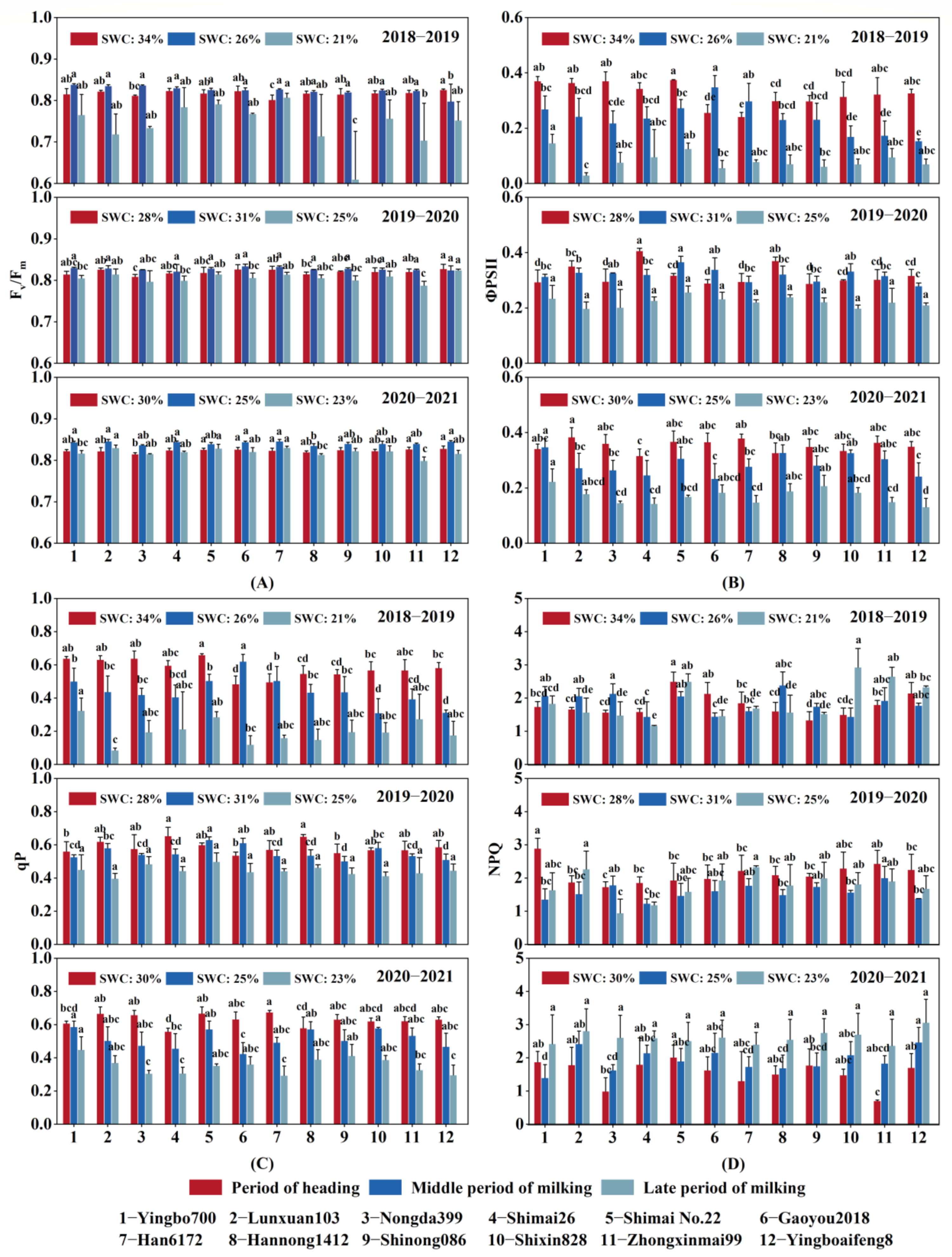
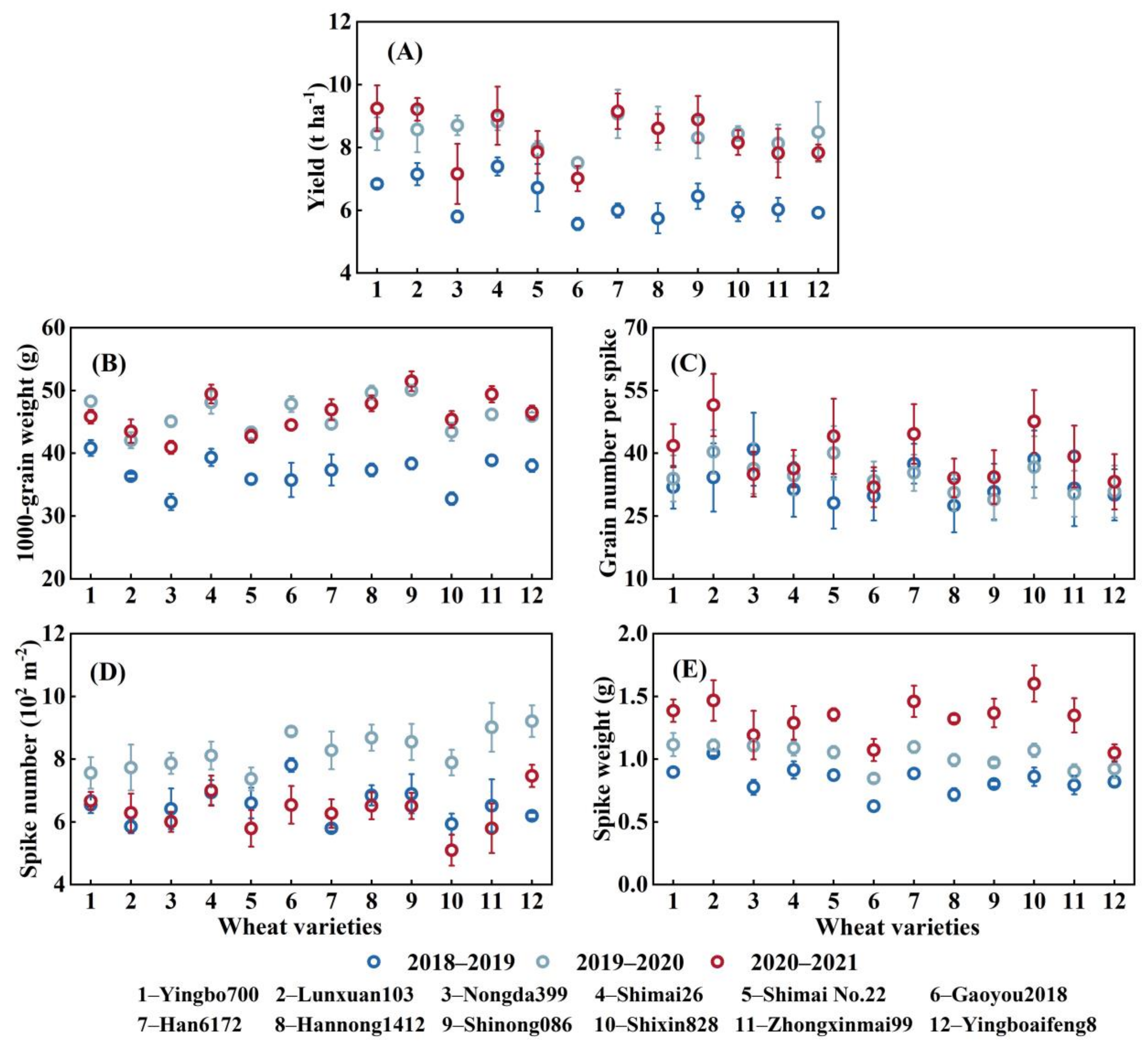

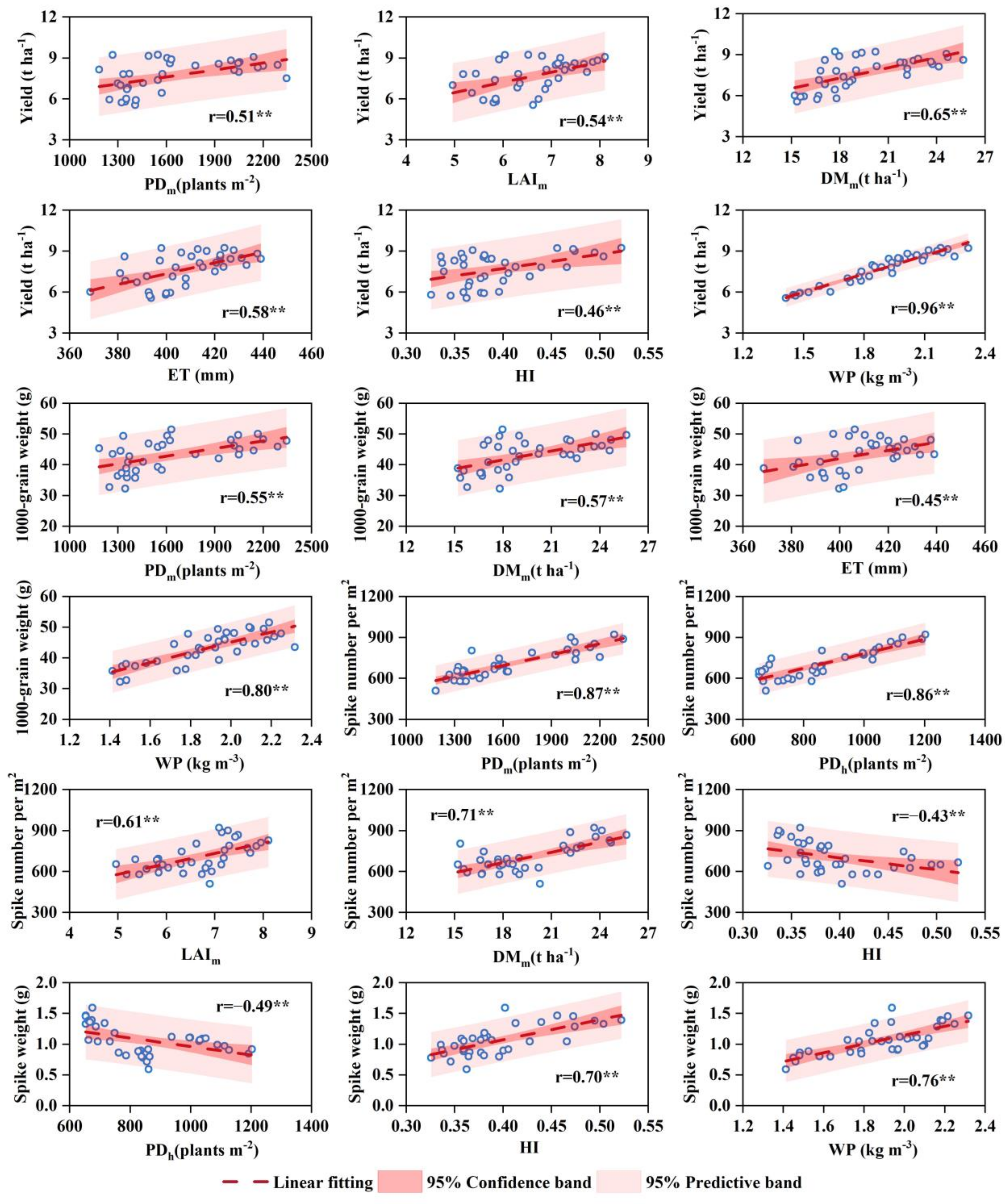

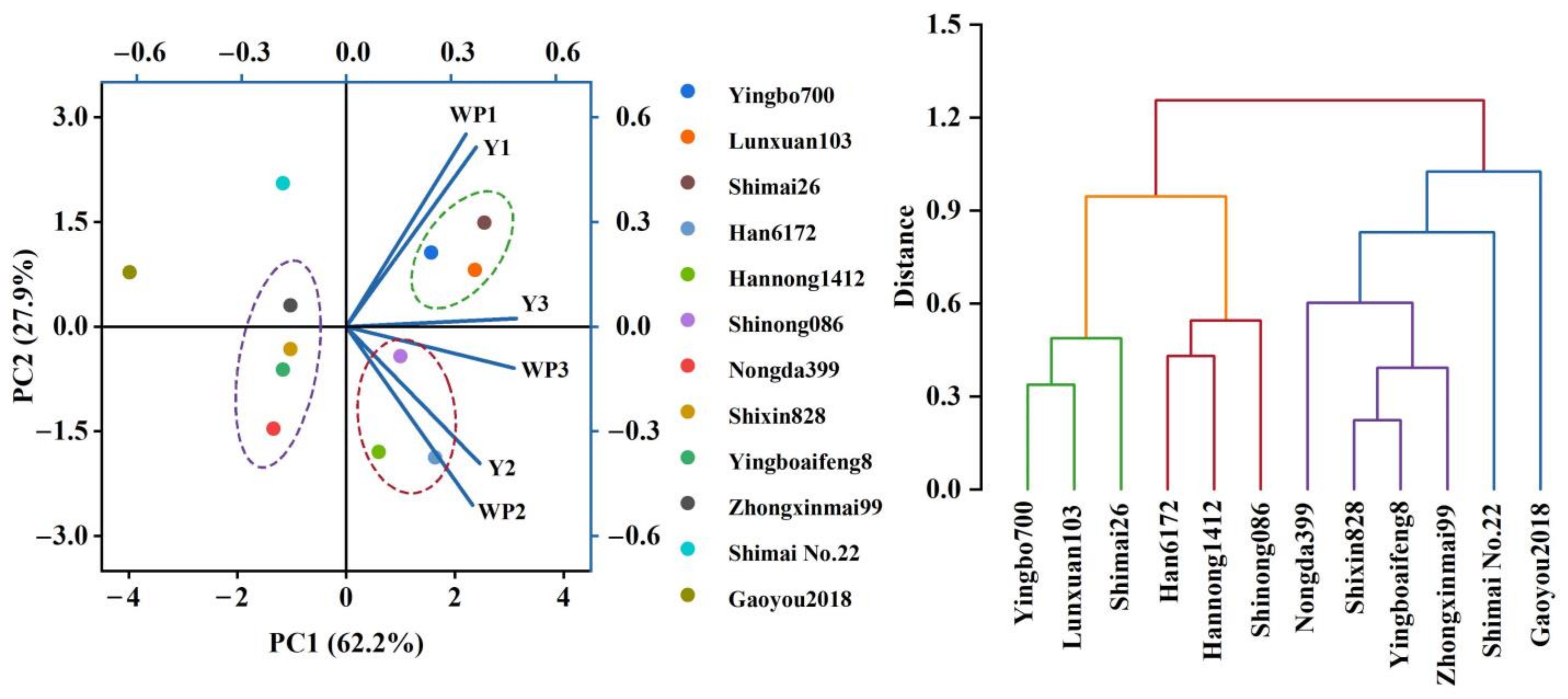
| Variety | Breeding Year | Varietal Characteristic | Growth Characteristics | Suitable Planting Area in the North China Plain |
|---|---|---|---|---|
| Lunxuan103 | 2010 | Winterness Medium maturity | High tillering ability More panicles per unit area | Moderate and high water and fertile plots in central and southern, central and northern Hebei Province |
| Shinong086 | 2009 | Semiwinterness Medium maturity | Medium tillering ability More panicles per unit area | Moderate and high water and fertile plots in central and southern, central and northern Hebei Province |
| Nongda399 | 2007 | Semiwinterness Medium maturity | High tillering ability More panicles per unit area | Moderate and high water and fertile plots in central and southern Hebei Province |
| Shimai No. 22 | 2006 | Semiwinterness Early maturity | Medium tillering ability More panicles per unit area | Moderate and high water and fertile plots in Henan Province (except for wheat following rice) |
| Yingbo700 | 2006 | Semiwinterness Medium maturity | High tillering ability More panicles per unit area | Moderate and high water and fertile plots in central and southern, central and northern Hebei Province |
| Han6172 | 1995 | Semiwinterness Medium maturity | High tillering ability More panicles per unit area | Moderate and high water and fertile plots in central and northern Hebei Province |
| Hannong1412 | 2011 | Semiwinterness Medium maturity | High tillering ability More panicles per unit area | Moderate and high water and fertile plots in central and southern, central and northern Hebei Province |
| Shimai26 | 2010 | Semiwinterness Medium maturity | High tillering ability More panicles per unit area | The southern part of Baoding and Cangzhou in Hebei Province and its southern part |
| Gaoyou2018 | 2005 | Semiwinterness Medium maturity | High tillering ability More panicles per unit area | Moderate and high water and fertile plots in Henan Province (except for wheat following rice) |
| Yingboaifeng8 | 2015 | Semiwinterness Medium maturity | High tillering ability More panicles per unit area | Moderate and high water and fertile plots in central and southern Hebei Province |
| Shixin828 | 2002 | Semiwinterness Medium maturity | Medium tillering ability More panicles per unit area | Moderate and high water and fertile plots in central and southern Hebei Province |
| Zhongxinmai99 | 2011 | Semiwinterness Medium maturity | High tillering ability More panicles per unit area | The southern part of Baoding and Cangzhou in Hebei Province and its southern part Moderate and high water and fertile plots in central and southern Hebei Province Winter wheat area of Shandong Province |
| Variety | PHm (cm) | PDm (Plants m−2) | LAIm (m2 m−2) | DMm (t ha−1) | ||||||||
|---|---|---|---|---|---|---|---|---|---|---|---|---|
| 2018–2019 | 2019–2020 | 2020–2021 | 2018–2019 | 2019–2020 | 2020–2021 | 2018–2019 | 2019–2020 | 2020–2021 | 2018–2019 | 2019–2020 | 2020–2021 | |
| Yingbo700 | 74.9 c * | 73.5 cd | 75.5 d | 1362 abc | 2200 abc | 1547 ab | 6.4 ab | 7.2 ab | 6.5 ab | 17.1 abc | 22.0 ef | 17.7 e |
| Lunxuan103 | 75.3 c | 75.6 bc | 75.7 d | 1298 bc | 1924 e | 1267 bc | 6.2 abc | 7.7 ab | 6.0 abc | 16.7 bcd | 22.6 de | 20.2 a |
| Nongda399 | 79.4 b | 75.8 b | 76.4 cd | 1344 abc | 2053 cde | 1456 abc | 5.9 bcd | 7.9 ab | 6.9 a | 17.8 ab | 22.9 d | 18.8 bc |
| Shimai26 | 74.9 c | 77.1 b | 81.6 bc | 1547 ab | 2000 de | 1604 a | 5.8 bcd | 8.0 ab | 7.2 a | 18.2 a | 24.7 b | 19.0 b |
| Shimai No. 22 | 83.5 a | 82.7 a | 86.3 a | 1356 abc | 2049 cde | 1370 abc | 6.9 a | 7.7 ab | 5.4 bc | 18.4 a | 22.2 def | 19.0 b |
| Gaoyou2018 | 75.7 c | 71.8 d | 74.9 d | 1407 abc | 2344 a | 1316 abc | 6.6 a | 7.2 b | 5.0 c | 15.4 de | 22.2 def | 18.6 bcd |
| Han6172 | 78.6 b | 77.5 b | 76.5 cd | 1351 abc | 2140 bcd | 1489 abc | 6.7 a | 8.1 a | 6.8 a | 16.7 bcd | 24.6 b | 19.4 b |
| Hannong1412 | 78.5 b | 76.9 b | 80.9 b | 1322 abc | 2044 cde | 1622 a | 5.7 cd | 7.5 ab | 7.1 a | 16.6 bcde | 25.7 a | 17.1 ef |
| Shinong086 | 79.0 b | 76.0 b | 80.1 bc | 1571 a | 2167 bcd | 1631 a | 5.4 d | 7.4 ab | 5.9 abc | 17.7 ab | 23.7 c | 18.0 cde |
| Shixin828 | 71.9 d | 75.2 bc | 74.5 de | 1247 c | 1747 f | 1183 c | 5.8 bcd | 7.3 ab | 6.9 a | 15.8 cde | 21.7 f | 20.3 a |
| Zhongxinmai99 | 75.5 c | 75.3 bc | 75.5 d | 1351 abc | 2020 cde | 1333 abc | 5.9 bcd | 7.3 ab | 4.9 c | 15.2 e | 24.1 bc | 17.8 de |
| Yingboaifeng8 | 67.7 e | 67.7 e | 71.1 e | 1411 abc | 2289 ab | 1576 ab | 5.6 cd | 7.1 b | 6.3 ab | 15.6 de | 23.6 c | 16.8 f |
| Mean value | 76.4 | 75.4 | 77.3 | 1381 | 2081 | 1449 | 6.1 | 7.5 | 6.3 | 16.8 | 23.3 | 18.6 |
| CV (%) | 5.3 | 4.7 | 5.1 | 6.8 | 7.8 | 10.5 | 8 | 4.5 | 12.9 | 6.7 | 5.4 | 6 |
| Index | Grain Yield | 1000-grain Weight | Grain Number Per Spike | Spike Number Per Square Meter | Spike Weight |
|---|---|---|---|---|---|
| Variety | 8.19 ** | 62.54 ** | 5.23 ** | 10.94 ** | 16.41 ** |
| Year | 178.67 ** | 895.23 ** | 148.91 ** | 263.75 ** | 379.90 ** |
| Variety×Year | 2.43 ** | 13.28 ** | 10.10 ** | 4.17 ** | 3.77 ** |
| Correlation Coefficients | PHm | PDm | PDh | LAIm | DMm | ETa | HI | WP |
|---|---|---|---|---|---|---|---|---|
| Grain yield | 0.06 | 0.51 ** | 0.10 | 0.54 ** | 0.65 ** | 0.58 ** | 0.46 ** | 0.96 ** |
| 1000-grain weight | −0.04 | 0.55 ** | 0.13 | 0.38 * | 0.57 ** | 0.45 ** | 0.36 * | 0.80 ** |
| Grain number per spike | 0.17 | −0.27 | −0.41 * | −0.02 | 0.03 | 0.30 | 0.40 * | 0.35 * |
| Spike number per m2 | −0.25 | 0.87 ** | 0.86 ** | 0.61 ** | 0.71 ** | 0.41 * | −0.43 ** | 0.22 |
| Spike weight | 0.20 | −0.10 | −0.49 ** | 0.09 | 0.17 | 0.32 | 0.70 ** | 0.76 ** |
| Correlation Coefficients | Heading Stage | Middle Milking Stage | Late Milking Stage | |||||||||
|---|---|---|---|---|---|---|---|---|---|---|---|---|
| Pn | Tr | Gs | LWUE | Pn | Tr | Gs | LWUE | Pn | Tr | Gs | LWUE | |
| Grain yield | 0.01 | −0.14 | −0.32 | 0.14 | 0.63 ** | 0.69 ** | 0.60 ** | −0.82 ** | 0.60 ** | 0.50 ** | 0.45 ** | 0.60 ** |
| 1000-grain weight | −0.08 | −0.23 | −0.40 | 0.19 | 0.54 ** | 0.62 ** | 0.54 ** | −0.73 ** | 0.61 ** | 0.51 ** | 0.49 ** | 0.66 ** |
| Grain number per spike | 0.20 | 0.28 | 0.12 | −0.23 | −0.02 | 0.02 | −0.05 | −0.15 | −0.02 | 0.06 | −0.02 | −0.05 |
| Spike number per m2 | −0.41 * | −0.53 ** | −0.51 ** | 0.52 ** | 0.56 ** | 0.64 ** | 0.64 ** | −0.56 ** | 0.72 ** | 0.65 ** | 0.68 ** | 0.45 ** |
| Spike weight | 0.24 | 0.20 | −0.02 | −0.20 | 0.19 | 0.22 | 0.12 | −0.43 ** | 0.11 | 0.09 | 0.01 | 0.28 |
| Correlation Coefficient | Heading Stage | Middle Milking Stage | Late Milking Stage | |||||||||
|---|---|---|---|---|---|---|---|---|---|---|---|---|
| Fv/Fm | ΦPSII | qP | NPQ | Fv/Fm | ΦPSII | qP | NPQ | Fv/Fm | ΦPSII | qP | NPQ | |
| Grain yield | 0.31 | 0.25 | 0.79 ** | −0.82 ** | 0.44 ** | 0.56 ** | 0.76 ** | −0.82 ** | 0.66 ** | 0.78 ** | 0.76 ** | −0.80 ** |
| 1000-grain weight | 0.34 * | 0.11 | 0.74 ** | −0.82 ** | 0.36 * | 0.51 ** | 0.78 ** | −0.83 ** | 0.59 ** | 0.7 ** | 0.77 ** | −0.80 ** |
| Grain number per spike | 0.05 | 0.31 | 0.16 | −0.37 * | 0.55 ** | 0.22 | 0.41 * | −0.35 * | 0.39 * | 0.17 | 0.44 ** | −0.33 |
| Spike number per m2 | 0.14 | −0.31 | 0.58 ** | −0.33 * | −0.28 | 0.40 * | 0.20 | −0.33 * | 0.13 | 0.52 ** | 0.08 | −0.33 |
| Spike weight | 0.27 | 0.42 * | 0.41 * | −0.64 ** | 0.65 ** | 0.34 * | 0.70 ** | −0.65 ** | 0.60 ** | 0.45 ** | 0.78 ** | −0.64 ** |
Disclaimer/Publisher’s Note: The statements, opinions and data contained in all publications are solely those of the individual author(s) and contributor(s) and not of MDPI and/or the editor(s). MDPI and/or the editor(s) disclaim responsibility for any injury to people or property resulting from any ideas, methods, instructions or products referred to in the content. |
© 2023 by the authors. Licensee MDPI, Basel, Switzerland. This article is an open access article distributed under the terms and conditions of the Creative Commons Attribution (CC BY) license (https://creativecommons.org/licenses/by/4.0/).
Share and Cite
Tang, X.; Liu, H.; Zhang, W. Physiological Characteristics, Crop Growth and Grain Yield of Twelve Wheat Varieties Cultivated in the North China Plain. Agronomy 2023, 13, 3041. https://doi.org/10.3390/agronomy13123041
Tang X, Liu H, Zhang W. Physiological Characteristics, Crop Growth and Grain Yield of Twelve Wheat Varieties Cultivated in the North China Plain. Agronomy. 2023; 13(12):3041. https://doi.org/10.3390/agronomy13123041
Chicago/Turabian StyleTang, Xiaopei, Haijun Liu, and Wenjie Zhang. 2023. "Physiological Characteristics, Crop Growth and Grain Yield of Twelve Wheat Varieties Cultivated in the North China Plain" Agronomy 13, no. 12: 3041. https://doi.org/10.3390/agronomy13123041
APA StyleTang, X., Liu, H., & Zhang, W. (2023). Physiological Characteristics, Crop Growth and Grain Yield of Twelve Wheat Varieties Cultivated in the North China Plain. Agronomy, 13(12), 3041. https://doi.org/10.3390/agronomy13123041






